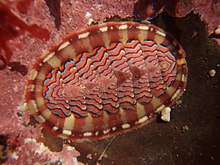
Chitons are marine molluscs of varying size in the class Polyplacophora, formerly known as Amphineura. About 940 extant and 430 fossil species are recognized.

The gumboot chiton also known as the giant western fiery chiton, is the largest of the chitons, growing to 36 cm (14 in) and over 2 kg (4.4 lb). It is found along the shores of the northern Pacific Ocean from Central California to Alaska, across the Aleutian Islands to the Kamchatka Peninsula and south to Japan. It inhabits the lower intertidal and subtidal zones of rocky coastlines.
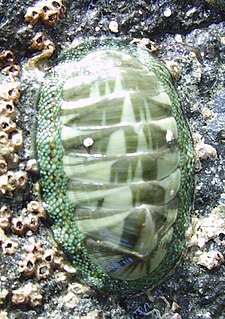
Chiton glaucus, common name the green chiton or the blue green chiton, is a species of chiton, a marine polyplacophoran mollusk in the family Chitonidae, the typical chitons. It is the most common chiton species in New Zealand. Chiton glaucus is part of a very primitive group of mollusc with evidence of being present in up to 80 million years of the fossil record.

Cryptoconchus porosus, the butterfly chiton, is a species of chiton, a marine polyplacophoran mollusc in the family Acanthochitonidae.
A mollusc valve is each articulating part of the shell of a mollusc. Each part is known as a valve or in the case of chitons, a "plate". Members of two classes of molluscs: the Bivalvia (clams) and the Polyplacophora (chitons) have valves.
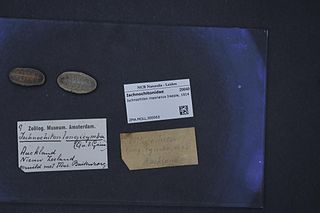
Ischnochiton maorianus, sometimes called the variable chiton, is a fast moving species of chiton in the family Ischnochitonidae, endemic to the main islands of New Zealand where it is abundant.

Tonicella lineata, commonly known as the lined chiton, is a species of chiton from the North Pacific.

Tonicella undocaerulea, commonly known as the blue lined chiton, is a species of chiton.
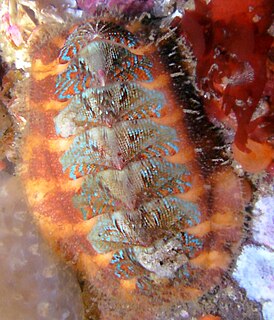
Mopalia spectabilis, commonly known as the red-flecked mopalia, is a species of chiton.

Chlamys varia, common name the variegated scallop, is a species of small scallop, a marine bivalve mollusk in the family Pectinidae, the scallops. It occurs in the North Sea, the English Channel, the northeastern Atlantic Ocean and the Red Sea.
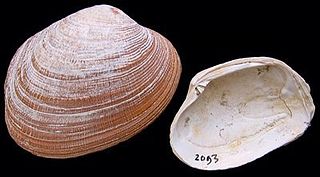
The grooved carpet shell, or Palourde clam, Ruditapes decussatus, or Venerupis decussatus, is a clam in the family Veneridae. It is distributed worldwide and due to its ecological and economic interest has been proposed as a bioindicator.
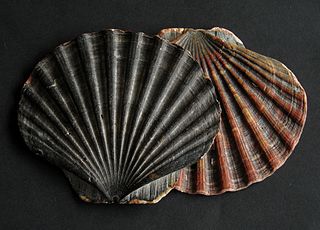
Pecten maximus, common names the great scallop, king scallop, St James shell or escallop, is a northeast Atlantic species of scallop, an edible saltwater clam, a marine bivalve mollusc in the family Pectinidae. This is the type species of the genus. This species may be conspecific with Pecten jacobaeus, the pilgrim's scallop, which has a much more restricted distribution.

Acanthopleura granulata, common name the West Indian fuzzy chiton, is a medium-sized tropical species of chiton. This type of chiton’s activity does not depend on spring-neap oscillations leading to lower locomotion loss. Its morphology is different from usual chitons as it has a fifth valve, which is split into halves.
Mopalia ciliata is a chiton in the genus Mopalia, commonly known as the hairy chiton. It is a medium-sized marine mollusc up to 5.0 cm in length. It is oval shaped with 8 separate moderately elevated, overlapping ridged valves on its dorsal surface. It resides along the coast of North America.

Katharina tunicata is commonly known as the black Katy chiton, black Leather chiton, black chiton, or leather chiton is a species of chiton in the family Mopaliidae.

An astronomical filter is a telescope accessory consisting of an optical filter used by amateur astronomers to simply improve the details of celestial objects, either for viewing or for photography. Research astronomers, on the other hand, use various band-pass filters for photometry on telescopes, in order to obtain measurements which reveal objects' astrophysical properties, such as stellar classification and placement of a celestial body on its Wien curve.

A girdle is part of the anatomy of a chiton, one class of marine mollusks, the class Polyplacophora. The shell of a chiton consists of eight valves which articulate with one another. The girdle is a strong but flexible structure that in most cases encircles the plates, holding them all together.

Plaxiphora tricolor is a species of chiton in the family Mopaliidae.

Tonicella insignis, White-lined chiton, or Red chiton, also known as the hidden chiton, belongs to the Tonicellidae family in the class of Polyplacophora, and the phylum of Mollusca. Its body length of T. insignis is around 5 cm.

Tonicella marmorea is a species of chiton, a polyplacophoran mollusc found in the Arctic Ocean and the North Atlantic Ocean. It was first described by the Danish missionary and naturalist Otto Fabricius.
